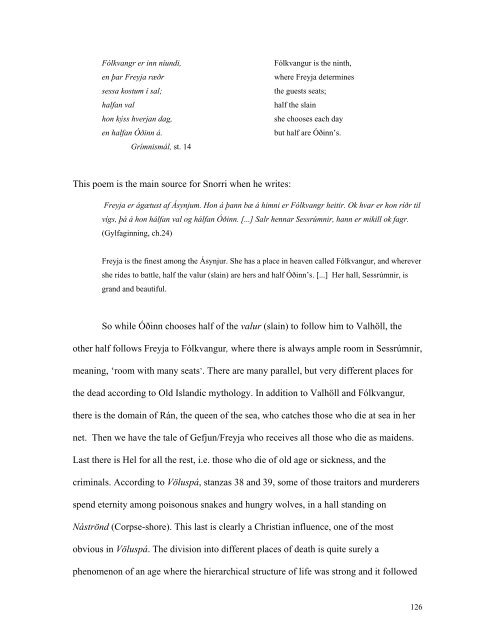You also want an ePaper? Increase the reach of your titles
YUMPU automatically turns print PDFs into web optimized ePapers that Google loves.
Fólkvangr er inn níundi,<br />
en þar Freyja ræðr<br />
sessa kostum í sal;<br />
halfan val<br />
hon kýss hverjan dag,<br />
en halfan Óðinn á.<br />
Grímnismál, st. 14<br />
This poem is the main source for Snorri when he writes:<br />
Fólkvangur is the ninth,<br />
where Freyja determines<br />
the guests seats;<br />
half the slain<br />
she chooses each day<br />
but half are Óðinn’s.<br />
Freyja er ágætust af Ásynjum. Hon á þann bæ á himni er Fólkvangr heitir. Ok hvar er hon ríðr til<br />
vígs, þá á hon hálfan val og hálfan Óðinn. [...] Salr hennar Sessrúmnir, hann er mikill ok fagr.<br />
(Gylfaginning, ch.24)<br />
Freyja is the finest among the Ásynjur. She has a place in heaven called Fólkvangur, <strong>and</strong> wherever<br />
she rides to battle, half the valur (slain) are hers <strong>and</strong> half Óðinn’s. [...] Her hall, Sessrúmnir, is<br />
gr<strong>and</strong> <strong>and</strong> beautiful.<br />
So while Óðinn chooses half <strong>of</strong> the valur (slain) to follow him to Valhöll, the<br />
other half follows Freyja to Fólkvangur, where there is always ample room in Sessrúmnir,<br />
meaning, ‘room with many seats’. <strong>The</strong>re are many parallel, but very different places for<br />
the dead according to Old Isl<strong>and</strong>ic mythology. In addition to Valhöll <strong>and</strong> Fólkvangur,<br />
there is the domain <strong>of</strong> Rán, the queen <strong>of</strong> the sea, who catches those who die at sea in her<br />
net. <strong>The</strong>n we have the tale <strong>of</strong> Gefjun/Freyja who receives all those who die as maidens.<br />
Last there is Hel for all the rest, i.e. those who die <strong>of</strong> old age or sickness, <strong>and</strong> the<br />
criminals. According to Völuspá, stanzas 38 <strong>and</strong> 39, some <strong>of</strong> those traitors <strong>and</strong> murderers<br />
spend eternity among poisonous snakes <strong>and</strong> hungry wolves, in a hall st<strong>and</strong>ing on<br />
Náströnd (Corpse-shore). This last is clearly a Christian influence, one <strong>of</strong> the most<br />
obvious in Völuspá. <strong>The</strong> division into different places <strong>of</strong> death is quite surely a<br />
phenomenon <strong>of</strong> an age where the hierarchical structure <strong>of</strong> life was strong <strong>and</strong> it followed<br />
126


